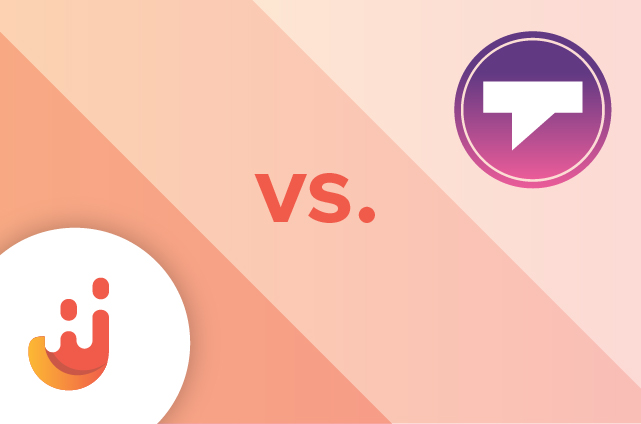Juicer and Taggbox are two of the most popular social feed widgets on the market — and for good reason too. They both let you pull content from multiple platforms easily, and publish them on a beautiful, central social feed.
So, it’s no surprise that they are top of your list when it comes to choosing the best aggregation platform for your content. In this article, we’ll discuss their features, pricing and everything in between Taggbox social media feed and the Juicer social media aggregator, so you can have enough information to make an informed choice.

What is Juicer?
Juicer lets you import content from multiple social media accounts and display it on your website as an aesthetically-pleasing social feed. Companies like Twix and London Business School use Juicer to create professional feeds that enhance their branding and boost content reach.
Features of Juicer include:
- Content curation: You can pull social posts, hashtags, images and so much more from your social accounts into a central feed.
- Feed analytics: You can see how people interact with your content. These reports will help you curate your feed for improved performance.
- Social media moderation: Juicer gives you complete control over what appears on your feed and how they appear. You can customize your feed’s visual appearance with brand colors and specific set ups. You can also filter the content that appears on your feed by preventing duplicate posts and content with certain keywords.
You can check out more of Juicer’s features on the website.
What is Taggbox?
Taggbox allows brands to create digital signages for attracting and engaging a wider audience. Its social media aggregator is part of a suite of tools for boosting user-generated content marketing.
Features of Taggbox include:
- Audience insights: You can see how people view and interact with the content on your social wall.
- Customized feed: Taggbox lets you customize your feed’s layout, colors and so much more.
- UGC tools: Brands and creators can use Taggbox to execute UGC campaigns. You can collect, organize and display user generated content on your website. This might be an overkill if you’re simply looking for a way to curate and display content on your website.
What are the most important social media widgets?
There are three primary features to consider when choosing a social media widget: integrations, price, and customization.
- Integrations: The first and most important feature to consider is that your social wall integrates with the platforms you need it to. If your aggregator can’t pull posts from a social platform you use often, it won’t serve much purpose. Second, you should consider the number of integrations allowed at once with the aggregator- if your brand engages with lots of social platforms at once, make sure the service you choose can curate them all.
- Price: Pay close attention to the features available at each pricing level of your compared tools- make sure you look at the price that applies to the services you need.
- Customization: If you need your social wall to be branded and consistent with the rest of the website, make sure you go with a social aggregator that allows full customization.
As we compare the social feed widget offered by Taggbox and Juicer, we will focus on those three segments specifically to determine which tool is best.
Juicer vs. Taggbox: How do they compare?
After an initial look at these two social media feed widgets, it can be difficult to pinpoint the differences between Taggbox and Juicer. There are many similarities, but once you become more familiar with each tool, you’ll begin to understand just how different these two social media feed platforms are from each other. Let’s start with their integrations.
Comparing Taggbox and Juicer: Social media integrations
Both tools have many integrations and aggregators in common, such as Facebook, Twitter, and Instagram. Here’s how they stack against each other.
| Social Media Platform | Juicer | Taggbox |
| ✅ | ✅ | |
| ✅ | ✅ | |
| ✅ | ✅ | |
| YouTube | ✅ | ✅ |
| ✅ | ✅ | |
| Flickr | ✅ | 🚫 |
| Tumblr | ✅ | ✅ |
| ✅ | ✅ | |
| Slack | ✅ | ✅ |
| SoundCloud | ✅ | ✅ |
| Vimeo | ✅ | ✅ |
| Yelp | ✅ | ✅ |
| Giphy | ✅ | ✅ |
| RSS | ✅ | ✅ |
Comparing Taggbox and Juicer: Pricing
Juicer has a forever-free plan ideal for small creators and solopreneurs looking for a simple way to display content. It also has three paid plans for small, midsize and enterprise companies — starting at $19 per month. You can check out Juicer’s full pricing and features — there’s something for everyone.
Taggbox is much more expensive than Juicer and tailored for mid-sized and enterprise businesses running large UGC campaigns. All its plans are paid, starting at $79 per month. But you can kick things off with a free trial.
If you’re running a large-scale display campaign, Taggbox might be worth a shot. If not, most of the extra features and money you spend on a Taggbox subscription might not be worth it. You’re better off with Juicer.
Comparing Taggbox and Juicer: Feed customization features
Because brand awareness is such an integral part of social media marketing, we understand the importance of being able to customize the look and feel of your social media feed’s appearance. At Juicer, our extensive social feed customization features allow you to tailor your feed to seamlessly blend in with your website design.
Juicer provides seven different social media wall templates to choose from- all of which can be fully customized, previewed, and tweaked within the Juicer dashboard.
You can make even more precise changes to your Juicer social feed by adding custom colors, changing the size of the columns, altering the width, modifying the height of the feed, or adjusting the feed’s scroll speed to create a truly unique end result. The free plan displays Juicer branding on the feed, but any of the upgraded plan options eliminate the branding.
Taggbox’s social feed widget uses a responsive design and offers options to adjust the feed with design elements. They also have integrations with other common marketing and CRM tools.
Which aggregator is best for your website?
Ultimately, your choice between Taggbox and Juicer will depend on your specific requirements, budget, and the level of customization and features you need for displaying social media content on your website or at events.
If you’re a large business looking for an all-in-one suite to power your entire digital media campaign, then Taggbox might be the right tool for you. But if you’re looking for a simple and effective way to collect, curate and display your content professionally, Juicer is definitely the tool of choice. It will help you appear professional and connect with a wider audience effectively.
Get started with a Juicer account.
Taggbox vs. Juicer: FAQs
We’ve answered some common questions you have about Taggbox and Juicer.
1. What is a social feed widget?
A social media feed widget therefore, allows you to embed that feed onto a website or display it at an event. Also known as social media aggregators or social walls, a social feed widget services are used by businesses and brands who want to display and track curated social media posts from across multiple platforms.
2. Do Taggbox and Juicer support real-time updates?
Yes, both tools offer real-time updates for your social media feeds, ensuring that the content displayed is current.
3. Which tool is more user-friendly for beginners?
Juicer is designed to be user-friendly and straightforward, making it a good choice for beginners or those with basic social media aggregation needs. But it also has advanced features for enterprise teams with more complex content aggregation needs.




